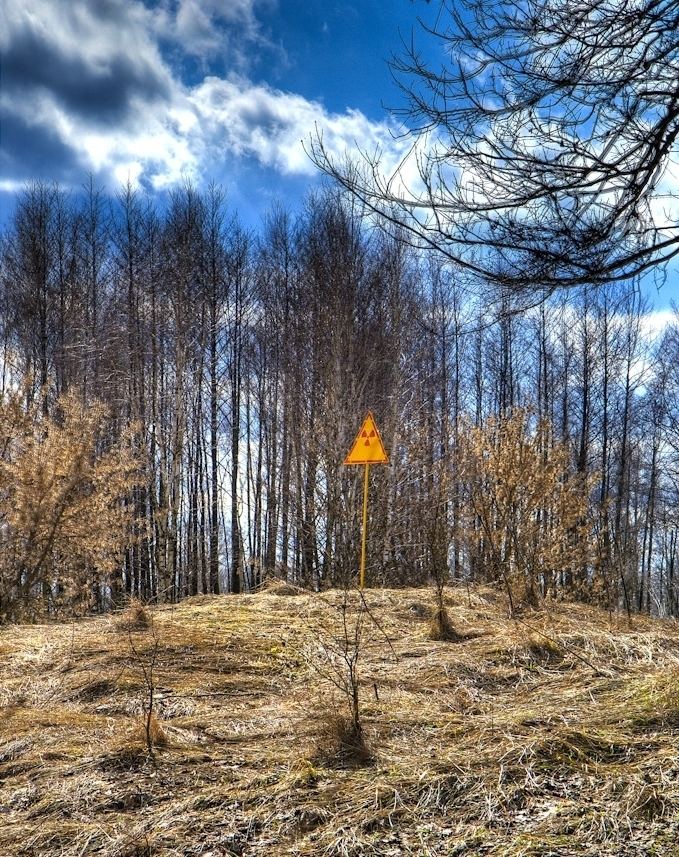Visitation With permission only | ||
 | ||
Status State controlled, restricted access Disturbance Large amounts of radioactive contamination | ||
The Red Forest (Ukrainian: Рудий ліс, Rudyi lis Russian: Рыжий лес Ryzhy les, literally "ginger-color forest") is the 10-square-kilometre (4 sq mi) area surrounding the Chernobyl Nuclear Power Plant within the Exclusion Zone. The name "Red Forest" comes from the ginger-brown colour of the pine trees after they died following the absorption of high levels of radiation from the Chernobyl accident on 26 April 1986. In the post-disaster cleanup operations, the Red Forest was bulldozed and buried in "waste graveyards". The site of the Red Forest remains one of the most contaminated areas in the world today.
Contents
Map of Red Forest
Disaster and cleanupEdit
The Red Forest is located in the zone of alienation; this area received the highest doses of radiation from the Chernobyl accident and the resulting clouds of smoke and dust, heavily polluted with radiation. The trees died from this radiation. The explosion and fire at the Chernobyl No. 4 reactor contaminated the soil, water and atmosphere with radioactive material equivalent to that of 20 times the atomic bombings of Hiroshima and Nagasaki.
In the post-disaster cleanup operations, a majority of the pine trees were bulldozed and buried in trenches by the "liquidators". The trenches were then covered with a thick carpet of sand and planted with pine saplings. Many fear that as the trees decay, radioactive contaminants will leach into the ground water. People have evacuated the contaminated zone around the Red Forest.
Wildlife refugeEdit
As humans were evacuated from the area in 1986, animals moved in despite the radiation. The flora and fauna of the Red Forest have been dramatically affected by the accident. It seems that the biodiversity of the Red Forest has increased in the years following the disaster. There are reports of some stunted plants in the area. Wild boar multiplied eightfold between 1986 and 1988.
The site of the Red Forest remains one of the most contaminated areas in the world. However, it has proved to be an astonishingly fertile habitat for many endangered species. The evacuation of the area surrounding the nuclear reactor has created a lush and unique wildlife refuge. In the 1996 BBC Horizon documentary "Inside Chernobyl's Sarcophagus", birds are seen flying in and out of large holes in the structure of the former nuclear reactor. The long-term impact of the fallout on the flora and fauna of the region is not fully known, as plants and animals have significantly different and varying radiologic tolerance. Some birds are reported with stunted tail feathers (which interferes with breeding). Storks, wolves, beavers, deer, and eagles have been reported in the area.
Today, radiation levels in the Red Forest can be as high as one Roentgen per hour, but levels of ten milliröntgens per hour are more common. More than 90% of the radioactivity of the Red Forest is concentrated in the soil.
Scientists are planning to use the nearby radioactive and abandoned town of Pripyat, and surrounding area, as a unique laboratory for modelling the dispersal of radionuclides by the detonation of a dirty bomb or an attack with chemical or biological agents. The area offers an unparalleled opportunity to fully understand the passage of radioactive debris through an urban and rural area.
The nature of the area seems to have not only survived, but flourished due to significant reduction of human impact. The zone has become a "Radiological Reserve", a classic example of an involuntary park. Currently, there is concern about contamination of the soil with strontium-90 and caesium-137, which have half-lives of about 30 years. The highest levels of caesium-137 are found in the surface layers of the soil where they are absorbed by plants, and insects living there today. Some scientists fear that radioactivity will affect the land for the next several generations.
In April 2015, a large forest fire burning nearly 400 hectares came within twenty kilometres of the abandoned nuclear power plant, raising fears the flames would burn shrub and woodland surrounding the disaster zone. This in turn could have released radioactive material into the atmosphere.
